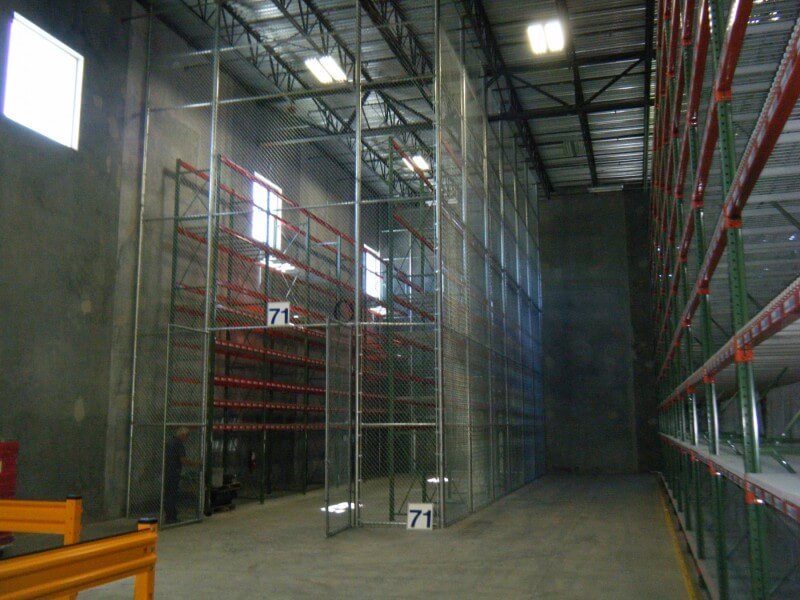Chain Link Gates: Installation, Security, and Durability
If you’re looking for a versatile, economical, and durable option to secure your property, look no further than chain link gates. Knowing how to choose the right gate — and how to install it correctly — can add years to its life while providing your property with top-notch security. In this comprehensive guide, we will walk you through everything there’s to know about chain link gates: from installation procedures to maximizing security and understanding their unrivaled durability. Dive in and learn why countless Texas homeowners continue to trust in the long-lasting value of chain-link fencing.

Types of Chain Link Gates
Chain link gates come in various types, each designed to suit different needs and provide specific benefits. Understanding these options can help you choose the right gate for your property. Let’s explore the most common types of chain link gates:
- Walk-through Gates: These gates are designed for pedestrian access and typically have a width ranging from 3 to 4 feet. Walk-through gates often feature a latch mechanism for easy opening and closing, allowing individuals to enter and exit the enclosed area conveniently.
- Single Swing Gates: Single swing gates are larger than walk-through gates, with widths typically ranging from 4 to 10 feet. They consist of a single panel that swings open and closed on hinges attached to one side of the gate frame. Single swing gates are ideal for areas where wider access is required, such as driveways or entrances.
- Double Swing Gates: Similar to single swing gates, double swing gates consist of two panels that swing open and closed. They are commonly used in wider openings, offering the advantage of a larger entrance space when fully opened. Double swing gates are often preferred for commercial properties or areas that require accommodating vehicles or machinery.
- Cantilever Gates: Cantilever gates operate by sliding horizontally along a set of rollers or wheels installed on a supporting structure, eliminating the need for a track on the ground. This design provides smooth operation even in uneven terrain and prevents snow, dirt, or debris buildup that may obstruct traditional sliding gates.
- Rolling Gates: Rolling gates utilize wheels at the bottom edge of the gate frame to roll along a track installed on the ground. This type of gate is commonly seen in commercial or industrial settings where security requirements demand large gate sizes. Rolling gates offer excellent strength and durability while providing easy access for vehicles.
It’s crucial to consider factors such as intended usage, available space, and desired level of security when selecting a chain link gate. Consulting with a professional fence installer can help you identify the most suitable option for your specific needs.
Installation Process for Chain Link Gates
Once you have chosen the type of chain link gate that best fits your requirements, it’s time to move forward with the installation process. Installing a chain link gate involves several steps to ensure proper functionality and longevity. Let’s take a closer look at the installation process:
- Prepare the Gate Opening: The first step is to clear and level the ground where the gate will be installed. This involves removing any obstructions, rocks, or debris from the area and ensuring a smooth surface.
- Set Gate Posts: Next, gate posts are positioned at each side of the opening and secured in place using concrete footings. The posts should be level and plumb to provide stability for the gate.
- Install Gate Frame: The gate frame is then assembled by connecting the top rail, bottom rail, and line posts together using appropriate connectors or fittings. The frame is attached securely to the gate posts.
- Attach Fabric: The chain link fabric is stretched tightly across the gate frame, starting from one end and proceeding to the other end. The fabric is secured firmly to the top rail, bottom rail, and line posts using tension bands and tie wires.
- Add Gate Hardware: Gate hardware such as hinges, latch mechanisms, and closing devices are installed according to the specific type of gate chosen. These components ensure proper operation and security.
- Adjustment and Testing: Once all the components are in place, adjustments may be necessary to ensure smooth opening and closing of the gate. Additionally, testing its functionality and making any final tweaks will guarantee optimal performance.
Proper installation techniques are vital for a sturdy chain link gate that withstands various weather conditions while providing security for your property. Hiring a professional fence installation company with expertise in chain link gates can ensure the process is done correctly, saving you time and hassle.
Adjusting the Length or Height of Gates
Chain link gates often require adjustments to their length or height to meet specific needs and accommodate various entry points. Whether you need to extend the gate to cover a wider driveway or adjust its height to enhance security, there are several approaches you can take. One option is to use gate extension kits, which typically include additional chain link fabric, tension bands, and other necessary hardware. These kits allow you to seamlessly extend the length of your gate by following simple installation instructions. By adding these extensions, you can ensure that your chain link gate fits perfectly and provides the desired level of functionality.
Consider a scenario where a homeowner installs a chain link gate across their driveway but realizes that it falls short in length, leaving a significant gap on both sides. To address this issue, they can purchase a gate extension kit that includes all the components needed for a smooth installation process. By following the provided instructions, they can easily extend the length of their gate, removing any unnecessary gaps and providing optimal coverage.
Another method for adjusting the length or height of chain link gates is through customization. In some cases, prefabricated gate extensions may not provide the exact fit required. In such situations, consulting with a professional fencing contractor who specializes in chain link gates is recommended. They can assess your specific requirements and tailor a solution that ensures an accurate fit and seamless integration with your existing gate.
It’s important to note that when making adjustments to the length or height of chain link gates, proper alignment and reinforcement are crucial for optimal performance and durability. Poorly executed modifications can compromise the integrity of the structure and reduce its overall effectiveness.
Enhancing Gate Security
As security is a vital consideration for any property owner, it becomes crucial to enhance the security features of chain link gates. Several measures can be taken to reinforce gate security effectively.
Installing privacy slats is one strategy to enhance gate security while also providing privacy. These slats are available in various materials, including plastic and aluminum, and can be inserted vertically into the chain link fabric. Privacy slats not only obstruct the view from outside but also reinforce the gate’s structure, making it more difficult to breach.
Imagine a business owner who wants to secure their commercial property with a chain link gate. They are concerned about potential intrusions and unauthorized access. In addition to standard security measures like locks, they decide to install privacy slats to deter prying eyes and reinforce the gate’s functionality. By installing these slats along the length of the gate, they provide an extra layer of security and peace of mind.
Another method to enhance gate security is by incorporating sturdy locking mechanisms. Traditional chain link gates often come with simple latch systems that can be easily manipulated. Upgrading to a more robust locking mechanism can significantly increase security. Options include heavy-duty padlocks, slide bolt latches, or even electronic keypad entry systems for added convenience.
In addition to physical enhancements, maintaining regular inspections and maintenance routines is essential for ensuring long-term security. This includes checking for any signs of wear or damage on the gate, inspecting hinges and locking mechanisms for proper functioning, and promptly addressing any issues that may arise.
Locking Mechanisms for Chain Link Gates
When it comes to chain link gates, ensuring proper security is of utmost importance. Choosing the right locking mechanism can enhance the overall functionality and effectiveness of your gate. There are various options available depending on your specific needs and preferences.
One popular choice for chain link gates is a padlock with a latch or hasp. This simple yet effective option provides convenience and security. The padlock can be easily attached to a latch or hasp, which prevents unauthorized access by keeping the gate securely closed.
For example, imagine you have a chain link gate that leads to your backyard. You want to ensure that only authorized individuals can enter the area. By installing a sturdy latch with a padlock, you can effectively secure the gate, preventing intruders from gaining access.
Another common locking mechanism for chain link gates is a slide bolt latch. This type of latch operates by sliding the bolt into a bracket or receiver on the opposite post. Slide bolt latches offer simplicity and reliability, as they securely lock the gate in place.
Alternatively, if you require more advanced security features, an electronic lock may be suitable for your chain link gate. These locks often use keypads or card readers for entry, allowing you to control access with personalized codes or access cards. Electronic locks provide an additional layer of protection by offering features like time-based access restrictions and audit trails.
Think of choosing a locking mechanism for your chain link gate as selecting the right lock for your front door – it needs to provide both security and convenience for daily use.
Remember that when selecting a locking mechanism for your chain link gate, consider factors such as durability, ease of use, and compatibility with your overall security system. It’s also important to regularly inspect and maintain the locking mechanism to ensure its optimal functionality over time.
Durability and Maintenance of Chain Link Gates
Durability is a key aspect to consider when installing a chain link gate. These gates are known for their strength and longevity, making them an excellent choice for various applications, including residential, commercial, and industrial settings.
Chain link gates are typically constructed using galvanized steel or other corrosion-resistant materials. This makes them highly resistant to rust and ensures that they can withstand exposure to the elements over time. However, it’s still important to understand how to properly maintain and care for your chain link gate to maximize its durability.
To start, regularly inspect the gate for any signs of damage or wear. Look out for loose or bent parts, sagging sections, or torn mesh. If you notice any issues, address them promptly to prevent further damage.
Ensure that the gate’s hinges and hardware are properly lubricated to ensure smooth operation and prevent rusting. Use a lubricant specifically designed for outdoor use to protect against moisture and friction.
In areas with particularly harsh weather conditions or intense sunlight, consider implementing additional protection measures such as UV-resistant coatings or applying sealants to prevent corrosion.
Lastly, keep vegetation surrounding the gate trimmed to avoid potential damage from overgrowth. Plants can sometimes grow through the chain link mesh or put pressure on the gate if they get too close. Regular maintenance in this regard will help preserve the integrity and functionality of your chain link gate.
With proper care and maintenance, your chain link gate can withstand years of use while remaining durable and reliable.
Weatherproofing Techniques
When it comes to chain link gates, weatherproofing is a vital aspect to consider, as the gates are often exposed to various climatic conditions. The goal is to ensure that the gates can withstand elements like rain, snow, humidity, and temperature fluctuations without compromising their integrity or aesthetic appeal.
One essential weatherproofing technique for chain link gates is applying a protective coating. This coating acts as a barrier against moisture and prevents rust and corrosion from developing. There are different types of coatings available, such as galvanized coatings or vinyl coatings.
Imagine living in an area with heavy rainfall or high humidity levels. Without proper weatherproofing techniques, your chain link gate might start showing signs of wear and tear, leading to rust formation. By applying a protective coating, you can safeguard your gate against these damaging effects of water and moisture.
Another method used to enhance weather resistance is through the use of vinyl slats or fabric inserts. These can be inserted into the chain link mesh, providing an extra layer of protection against wind, rain, or prying eyes. Not only do these inserts offer privacy and security benefits but they also act as a shield against the elements.
Additionally, proper installation techniques play a crucial role in ensuring the durability of chain link gates. When installed correctly with sturdy posts anchored securely in the ground, the gates have better resistance against strong winds and other forces that could potentially damage them during inclement weather conditions.
Aesthetic and Functional Design Options for Chain Link Gates
Chain link gates are known for their functional benefits such as security and durability, but that doesn’t mean they have to compromise on aesthetics. Advancements in design options have made it possible to create visually appealing chain link gates that seamlessly blend with the surrounding environment while still serving their primary purposes.
One popular design option for chain link gates is adding decorative elements or patterns. By incorporating decorative inserts, such as scrolls, finials, or ornamental tops, the gates can transform into a focal point of admiration rather than just a functional barrier. These decorative additions can be customized to match the architectural style of the property or create a unique look that reflects your personal taste.
For example, imagine having a chain link gate adorned with elegant scrolls at the entrance of your garden. It not only enhances the overall aesthetic appeal but also adds a touch of sophistication to your outdoor space.
An alternative approach to enhance both aesthetics and functionality is by integrating privacy slats. These slats can be inserted into the chain link mesh, offering varying levels of privacy depending on your preferences. The slats are available in different colors and textures, allowing you to create a cohesive and stylish appearance that complements your property’s design.
Let’s say you have a chain link gate surrounding your backyard pool area. Adding privacy slats in a modern gray shade not only ensures privacy but also lends a contemporary vibe to the space.
Furthermore, color options for chain link gates have expanded beyond the traditional silver or galvanized finish. Powder coating technology allows for customization with an array of colors that can suit any style or theme. This versatility ensures that your gate becomes an integrated part of your overall landscape design rather than just a functional afterthought.
Accommodating Accessibility Requirements
When installing a chain link gate, it is essential to consider and accommodate accessibility requirements. Accessibility is a fundamental aspect to ensure that everyone, regardless of their physical abilities, can enter and exit the gated area comfortably and safely. This is particularly important in public spaces, commercial establishments, or residential properties where individuals with disabilities may need to access the premises.
One crucial consideration for accommodating accessibility requirements is the width of the gate. The gate must be wide enough to enable the passage of wheelchairs, walkers, or other mobility aids. A standard chain link gate typically has a width of about 3 to 4 feet, which may accommodate most individuals. However, for wheelchair users, it is recommended to have a wider gate reaching approximately 5 feet or more. This extra space allows for easier maneuverability and ensures a smooth entry and exit experience for individuals with mobility challenges.
In addition to the width of the gate, another important aspect is the height clearance. A chain link gate should have sufficient vertical clearance to accommodate both standing and seated individuals. The Americans with Disabilities Act (ADA) recommends at least 80 inches of clearance to ensure unhindered passage for most people. It is crucial to adhere to these guidelines when installing a chain link gate in public places or properties subjected to ADA regulations.
Let’s consider an example: Imagine an office building that aims to provide equal access for all employees and visitors. They decide to install a chain link gate at the entrance of their parking lot. To accommodate accessibility requirements, they opt for a wider gate measuring 6 feet in width instead of the standard 4 feet. Furthermore, they ensure a height clearance of 84 inches to guarantee comfortable passage for wheelchairs or tall individuals.
Besides width and height considerations, additional features should be incorporated into your chain link gate design to enhance accessibility. These may include:
- Swing Gate Mechanism: Installing a swing gate mechanism allows the gate to open easily without requiring excessive force or complicated entry procedures.
- Lever-style Handles: Utilizing lever-style handles instead of knobs ensures that individuals with limited hand dexterity can easily operate the gate.
- Clear Signage: Proper signage highlighting accessible entrances, and clear directions assist individuals in locating the appropriate gate for their needs.
By incorporating these accessibility features into your chain link gate installation, you create an inclusive environment where individuals of all abilities can navigate freely and safely.
Imagine the relief and appreciation felt by a wheelchair user when they encounter an accessibly designed chain link gate that allows them to enter a property seamlessly. By considering accessibility requirements, we promote inclusivity and enhance the overall experience for everyone involved.
In conclusion, accommodating accessibility requirements is crucial when installing a chain link gate. This involves considering factors such as gate width, height clearance, swing gate mechanisms, lever-style handles, and clear signage. By adhering to accessibility guidelines and creating an inclusive environment, we ensure that all individuals, regardless of their physical abilities, can enter and exit the gated area comfortably and safely. The professionals here at Texas Fence are ready to help install your new Chain Link Gates. Call us today at (281) 807-7900.








